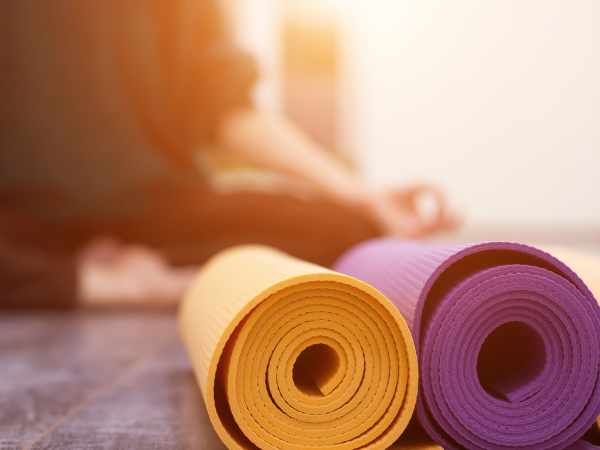Yoga for Arthritis
Physical activity is essential for managing arthritis symptoms and preserving mobility. And yoga is an excellent, gentle, low-impact form of exercise that offers both physical and psychological benefits like stress management techniques, including breathing, mindfulness and relaxation.
However, all types of yoga aren’t appropriate for individuals with arthritis. Every case of arthritis is different, so one person may be able to perform a pose with ease while another may experience pain or discomfort. The bottom line: there is a type of yoga for everyone at every level.
Getting Started with Yoga
Some yoga poses that individuals without joint pain can perform might look painful to a person with arthritis. But that shouldn’t be a deterrent. Poses can be adapted for different needs and abilities. For example, you could use balance aids like chairs, blocks, or straps. There are even yoga poses that can be done in bed!

Just make sure to consult your doctor before adding yoga to your physical activity regimen. Certified Yoga therapists who have additional training to address the needs of people with diverse conditions and abilities can also be a great resource. And many individuals living with arthritis teach yoga.
The Best Yoga for Arthritis
There isn’t one best type of yoga for arthritis because arthritis is an umbrella term that includes over 100 different conditions. No one’s symptoms, pain or abilities are exactly the same. Though, a yoga style like Iyengar is a great place to start as it includes gentle, flowing movements and allows for the use of chairs and other props to help with balance.
The Worst Yoga for Arthritis
Some types of yoga, like vinyasa, involve quickly moving from pose to pose and count as an aerobic workout. For these, it’s best to regularly practice so you can build up strength and flexibility before trying faster motions or more weight-bearing moves.
Remember to always avoid poses that hurt. These might require joints to bend too much on the knees or wrists, require balancing on one foot or getting up off the ground. Some types of yoga that involve longer breathing sessions can also aggravate the joints because they require a person to remain in the same pose for longer.
If you are new to yoga and have arthritis, it is best to avoid yoga classes such as:
- Power
- Ashtanga
- Bikram
- Hot Yoga
- Kundalini
What Research Says About Yoga for Arthritis
Dr. Susan Bartlett is a researcher at Arthritis Research Canada (based at McGill University) and has done several studies on yoga and arthritis.
In one of her studies, participants living with rheumatoid arthritis who practiced yoga reported a 20 per cent improvement in physical health, reduced pain and a boost in energy and feelings of peace and happiness. And, when researchers looked at the data nine months later, the improvements were still evident.
“Creating a regular yoga routine best suited for you can improve muscle strength and joint flexibility, while boosting mood and controlling stress,” Bartlett said.
To read more about Bartlett’s research, click here.
The Physical Benefits:
What Patients Say about Regular Yoga for their Arthritis
Yoga offers many benefits for individuals living with arthritis. It can reduce joint stiffness, improve range of motion, and help with flexibility. For these reasons, people with arthritis often practice yoga first thing in the morning and before bed when joint pain/stiffness is often at its worst. But it can be helpful when practiced at any time of day.
Eileen Davidson, a 35 year old mother with rheumatoid arthritis, includes yoga poses in her daily stretching routine.
“Yoga helps alleviate morning stiffness and pain and deep breathing exercises really help reduce my anxiety,” said Davidson, who is also a member of Arthritis Research Canada’s Arthritis Patient Advisory Board.
She can’t do every yoga pose because of her rheumatoid arthritis. Instead, she focuses on the ones that give her the biggest benefits without causing pain.
“Sometimes I do yoga in my chair if I feel like getting up off the ground that day may be a challenge,” she said.
Jon Collins is another member of the Arthritis Patient Advisory Board who practices yoga to help with his osteoarthritis and psoriatic arthritis. He incorporates several poses into his daily exercise program and has discovered some big benefits.
“While I find it difficult to do yoga, I have noticed increased flexibility, stress relief and my core has strengthened, which has helped my golf game,” Collins said. “Don’t be intimidated by yoga. Even instructors with no knowledge of arthritis can easily help you adapt poses to meet your needs.”
Susan Le is 34, living with lupus and the mother of a toddler. She practices flow, hatha, restorative, yoga nidra, and yoga for kids. She chooses the type of yoga based on her energy level. Flow or hatha if she has more energy. Slower hatha, restorative or nidra if she is feeling tired.
“Yoga itself has taught me to tune into my own body and move with it,” Le said, who now involves her son in her yoga practices.




















































